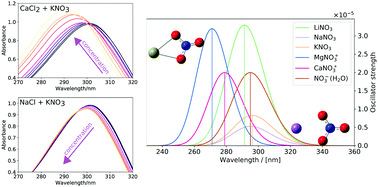The unexpected effect of aqueous ion pairs on the forbidden n → π* transition in nitrate†
Abstract
Aqueous nitrate is ubiquitous in the environment, found for example in stratospheric clouds, tropospheric particulate matter, rain and snow, fertilized fields, rivers and the ocean. Its photolysis is initiated by absorption into the strongly forbidden n → π* transition. Photolysis reactivates deposited nitrate, releasing nitrogen oxides, and UV light is commonly used to break down nitrate pollution. The transition is doubly forbidden unless its symmetry is broken, giving a powerful means of probing the interactions of nitrate with its environment and of using experiment to validate the results of theory. In this study we demonstrate the remarkably different effects of the addition of a series of mono- and di-valent metal chlorides on the nitrate UV transition. While they all shift the transition to shorter wavelengths, the shift changes significantly from one to another. For the monovalent series Li+, Na+, K+, the blue shift decreases down the column being strongest for Li+ and weakest for K+. For the divalent series Mg2+, Ca2+, Ba2+, the opposite effect is observed with the energy shift of Ba2+ being an order of magnitude larger than for Mg2+. The absorption intensity also changes; the addition of Na+ and K+ decrease intensity whereas Li+ increases intensity. For the divalent cations an increase is seen for all three members of the series Mg2+, Ca2+ and Ba2+. Paradoxically, the effect of addition of CaCl2 to the solution is to decrease the environmental photolysis rate of nitrate; despite the increase in intensity, Ca2+ blue shifts the peak position above the tropospheric photolysis threshold around 300 nm. Using computational chemistry we conclude that the effects are due to the microscopic interactions of the nitrate anion and not continuum effects. Two microscopic mechanisms are investigated in detail, the formation of a nitrate monohydrate cluster and a contact ion pair. The contact ion pair shows the potential for significant impact on the energy and intensity of the transition.



 Please wait while we load your content...
Please wait while we load your content...